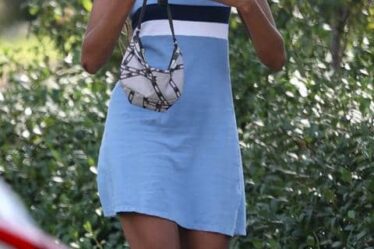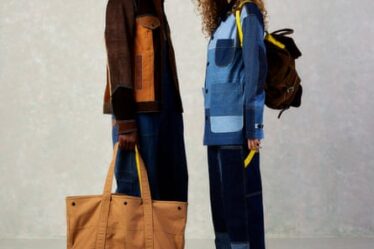
Of the different vintage Gap pieces Erin Wylie has bought recently, her favourite is a wine-coloured anorak in a soft, papery cotton. What she likes are the subtle details: the look and feel of the material, and small choices like the colour-matched silicone stopper on the drawcord of the hood.
“Really beautiful little details that you wouldn’t probably see today,” said Wylie, who writes the style and culture newsletter Blackbird Spyplane with her partner, Jonah Weiner, and featured the anorak in a recent issue on the decline of thrifting.
Though, to be fair, she admits she’s not the best person to ask what Gap currently has for sale.
“I haven’t been in a Gap in maybe a decade,” she said, “so I don’t really know what’s going on there.”
Driven partly by nostalgia and partly by the trend among younger shoppers for 1990s and Y2K styles, people are snatching up products from Gap’s heyday. But those same shoppers aren’t necessarily buying what Gap has in stores now.
On eBay, the number of sold items with “Y2K Gap” in the name more than doubled in May 2023 compared to the prior year and sold items labelled “90s Gap” were up double digits, according to Charis Marquez, the company’s vice president of global fashion. Depop, a resale marketplace popular with Gen-Z, said it saw searches for “vintage Gap” jump 114 percent in June.
Yet at Gap itself, sales in the quarter through April were down 13 percent versus the prior year. The company cited extra challenges, like the sale of its China business and the shuttering of its ill-fated Yeezy Gap line, but falling revenues are not a new phenomenon for the US retailer. Annual sales are half what they were in the early 2000s.
In theory, Gap should be in a prime position to benefit from the 1990s and Y2K trends. It’s certainly trying: the brand recently enlisted Sean Wotherspoon, a designer who has made a name for himself in the sneaker world and is also co-founder of the Round Two vintage chain, to curate a capsule collection of vintage Gap products. A first drop of items such as well-worn button-ups and washed-out denim quickly sold out.
But the same desire doesn’t seem to be translating to Gap’s current offering, in part, critics say, because the brand has lost its identity and the quality has gone downhill. In that sense, Gap may be reflective of a bigger shift in fashion as cheap clothing has proliferated and pressure has grown on everyone to keep prices down.
“They certainly have changed course, which is well different than what it was,” said Mickey Drexler, who oversaw Gap from 1983 to 2002 and currently serves as chairman of Alex Mill, which he pitches as trying to fill a hole in the market for stylish, quality clothing at good prices.
The Appeal of Vintage Gap
The Gap items attracting buyers include vintage T-shirts, sweatshirts, denim and more. On eBay, the number of vintage Gap T-shirts sold globally in May was up more than 60 percent year-over-year. Sweatshirts sold jumped more than 50 percent, and in the US and Canada combined, leather jackets increased about 40 percent. Other popular items included easy fit jeans and Wylie’s beloved anoraks.
The trend isn’t totally new. Depop said there was a spike in searches between November and December 2020, and then the greatest increase happened between June and October 2022. But the interest hasn’t faded. Since the start of 2023, searches for vintage Gap jeans are up just over 100 percent, while Gap hoodies, shorts and T-shirts are the most popular sold items, with menswear showing a higher growth rate than womenswear.
“It’s high-quality, it’s made well and there can be some really cool and interesting pieces,” said Malcolm Rose, a vintage reseller and co-founder of the brand Alma.
He said there has always been demand for vintage Gap items, some of it fuelled by nostalgia among those who grew up with Gap. Wylie said part of the appeal of the anorak is that she believes her brother had the same one.
Of course, many Gen-Z shoppers were too young to remember when Gap ruled the American teenager’s wardrobe. But there are other attractions, too. Rose said the pieces had a clear aesthetic direction: a modern and approachable version of Americana. Wylie highlighted the way the prep and workwear influences combined and tie into the unisex trend now.
“For me, I always like pieces that are kind of rugged but they’re well-made, and often they have a little bit of a patina,” she said.
Just how well made the pieces are might depend on your point of view. Drexler emphasised that in his time at Gap they tried to offer excellent value for the price, but they would never spend extra on fancy fabrics and construction techniques the end customer probably wouldn’t have recognised or cared about anyway.
Still, the products were arguably of better overall quality than at present. Jessica Ramirez, a senior research analyst at Jane Hali & Associates, an investment research firm, pointed to the fabrics as something that has noticeably changed.
“When you go into the store and physically touch the product, the quality has really deteriorated over the years,” she said.
Can Gap Recapture the Magic?
Wylie has a theory about why the quality has fallen. When she was growing up, Gap was pricey for her family. Often she’d have to wait for clothes to go on sale. Sometimes she and her mom would even split the cost and share an item. But today, Gap’s prices aren’t much different than they were decades ago, even though everything else has gotten more expensive.
It suggests the company is making its clothes much more cheaply, which translates into their look and feel. Right now, for instance, the company is selling a women’s cotton T-shirt for $9, marked down from $24.95. Drexler said when he joined the company in the early 1980s, a T-shirt might cost $15.
The situation wouldn’t be unique to Gap. In the US, clothing prices haven’t kept pace with overall inflation, making clothes less expensive than they used to be relative to other goods — the result of decades of brands finding cheaper ways to make and sell their goods, driven by forces like globalisation, the spread of fast fashion and the rise of e-commerce. (Thrift shoppers have for years lamented that vintage stores are filling with cheap clothes made of thinner fabrics loaded with synthetics, which may not hold up as well to repeated washing and drying over time.) Like everyone else, Gap is trying to make sure its products are competitively priced.
“We stand behind the quality of our products, and equating lower prices to lower quality shows a misunderstanding of how supply chains have changed since the 1990s,” a Gap spokesperson said in an emailed statement. “They are more global and more efficient, leveraging new technologies and economies of scale to keep prices affordable for consumers without sacrificing quality.”
Product quality doesn’t by itself explain Gap’s current struggles though. Ramirez pointed out that everyone faces the same competition, and other legacy brands such as Levi’s and lately even Abercrombie & Fitch have managed to engineer turnarounds. Many of Gap’s problems are its own. She noted that Gap had missed trends like the resurgence of denim and the 1990s and Y2K explosion.
“For the most part, the assortment isn’t very enticing,” she said. “The way that they engage with the consumer isn’t very modern.”
Gap said in its email that it tries to find a balance between new and classic styles, and some of its icons like its ’90s loose denim, pocket T-shirts and logo hoodie are among its current best sellers.
Ramirez and Wylie both brought up Gap’s marketing in the 1990s, with Wylie describing Gap at the time as a strong brand that lured people in. Gap has made attempts to revive its image, including by partnering with Ye, who put a dark, dystopian stamp on Gap items. But the tie-up always felt disconnected from the rest of the Gap brand, which struggles on its own to stand out in the marketplace.
“The identity that they hold now isn’t really as strong as it used to be,” Rose, the vintage reseller, said. “The clothing reflects that.”
Drexler noted that the most important part of any business today is “the product, the goods.” He said he’s always used the same formula and it hasn’t really changed: the aim should be to offer good-looking merchandise with taste, a point of view and fair pricing relative to value.
If nothing else, the desire for vintage Gap shows that the brand still has a place in shoppers’ minds. It has to figure out how to recapture their wallets, too.



